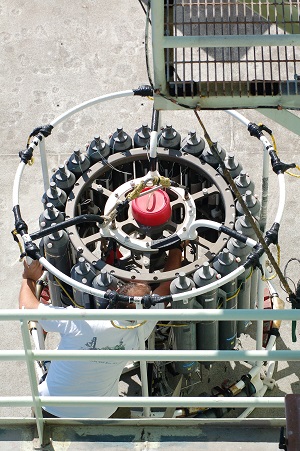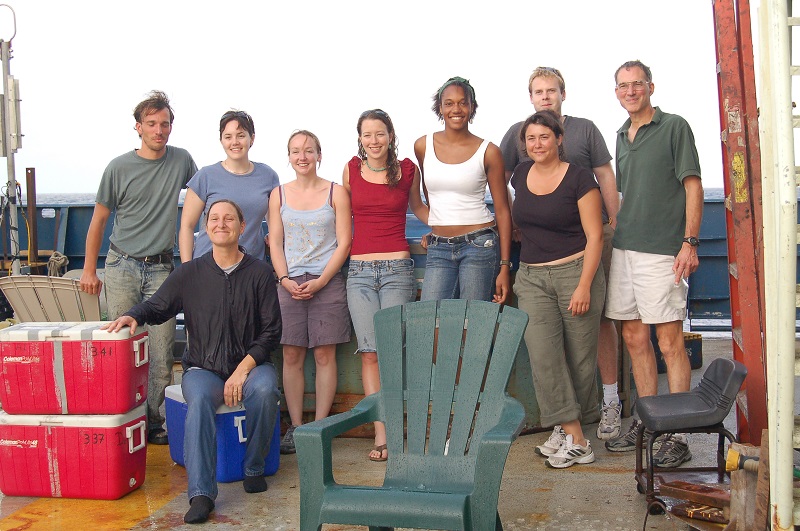LArval Dispersal along the Deep East pacific Rise (LADDER)
Principal Investigators: L. S. Mullineaux, A. M. Thurnherr, J. R. Ledwell, D. McGillicuddy, and J. W. Lavelle

Jim Ledwell, Brian Guest, and Ryan Jackson (Postdoctoral Fellow, now at USGS in Urbana, IL) with the tracer injection system mounted on Alvin's "basket."
Project Summary
When hydrothermal vent communities were first discovered 25 years ago, biologists immediately recognized the key role of dispersal in the dynamics and persistence of the populations. Despite substantial progress on this topic over the past 10 years, some very important questions remain unanswered about the mechanisms of dispersal and their effects on population dynamics, population genetics and community structure. Investigators have hypothesized that larval dispersal is driven largely by physical transport processes. The primary objectives of this project are to investigate how larval behaviors interact with topographically-influenced flows on mid-ocean ridges, and to determine how these interactions affect dispersal trajectories, maximal dispersal distances, and relative probabilities of supply to natal versus remote vents.

Top view of the rosette deployed during the cruise.
We have identified three specific ecological questions to address:
- What are the influences of advection and eddy diffusion on the maximal dispersal distance of vent species with given larval life spans?;
- What are the effects of ontogenetic changes in larval behavior (i.e., vertical positioning) on species' dispersal distances; and
- How are the probabilities that larvae will be lost from the ridge system influenced by topography and flow? Might the axial summit trough inhibit off-axis transport of larvae, and serve as a conduit between habitable vent sites?
Our project also addresses several issues of interest to the physical oceanography community, including:
- What are the mean and temporally varying flows in the vicinity of a mid-ocean ridge crest, and what is their spatial structure and coherence?;
- What is the magnitude of the diapycnal diffusivity near the ridge crest?;
- How rapid is lateral dispersion, and how effective is lateral homogenization by eddy diffusion near the ridge crest?
Our dispersal questions cannot be answered without an integrated set of physical and biological approaches. We have assembled a diverse team of observationalists and modelers to investigate relevant aspects of ridge-associated oceanography and biology, and to combine them into a quantitative model of dispersal. The approach includes a tracer release in the field, current meter measurements, a hydrodynamic/transport model, measurements of larval positions and stages in the field, and a coupled biological/physical model. We have chosen to study the region near 9:50N on the East Pacific Rise (EPR), a site that has been the focus of much interdisciplinary research in the past and has been selected as an Integrated Study Site by the NSF Ridge 2000 program.

A broad impact of this result will be achieved through several different activities. The approaches and results from the proposed studies will be incorporated into graduate courses, and into presentations given to local K-12 classes. Two graduate students will be supported, and undergraduates will be integrated through the WHOI Summer Student Fellowship program and the NSF REU program. We will link our research with web-based outreach efforts including Dive and Discover.
The long-term benefits of the proposed activity to society will be achieved by contributing to a general understanding of retention, dispersal, and connectivity of marine populations, and to a better understanding of seafloor topographic effects on flows and mixing. Vent systems are subject to increased use by researchers, tourists and industry (e.g., extracting polymetallic minerals, and sampling fauna for natural products discovery and pharmaceutical applications). Our results will inform efforts to develop plans for sustainable use of vent ecosystems.
Disclaimer
The material found on this page is based upon work supported by the National Science Foundation under Grant No. 0425361. Any opinions, findings, and conclusions or recommendations expressed in this material are those of the author and do not necessarily reflect the views of the National Science Foundation.
Some Papers
Jackson, P. R., J. R. Ledwell, and A. M. Thurnherr (2010), Dispersion of a tracer on the East Pacific Rise (9°N to 10°N), including the influence of hydrothermal plumes, Deep Sea Res. Part I, 57(1), 37-52, doi:http://dx.doi.org/10.1016/j.dsr.2009.10.011.
Lavelle, J. W., A. M. Thurnherr, L. S. Mullineaux, D. J. McGillicuddy Jr., and J. R. Ledwell (2012), The prediction, verification, and significance of flank jets at mid-ocean ridges, Oceanography, 25(1), 277-283, doi:http://dx.doi.org/10.5670/oceanog.2012.26.
Mullineaux, L. S., D. J. McGillicuddy Jr., S. W. Mills, V. K. Kosnyrex, A. M. Thurnherr, J. R. Ledwell, and J. W. Lavelle (2013), Active positioning of vent larvae at a mid-ocean ridge. Deep-Sea Res. Part II, 92, 46-57, doi:http://dx.doi.org/10.1016/j.dsr2.2013.03.032.
